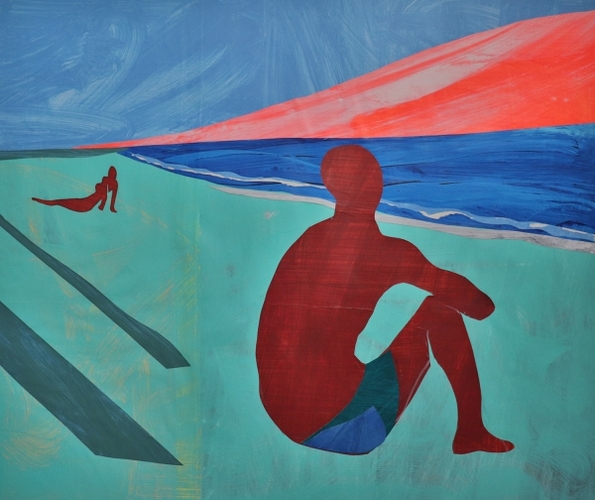BRATTLEBORO — Vermont may be landlocked, but visitors to the Brattleboro Museum & Art Center can practically feel the spray of the ocean and the sand beneath their feet this summer.
In “Ocean's Edge,” artists David Kapp, Graham Nickson, and Isca Greenfield-Sanders transport viewers to beaches from Maine to Mexico. The exhibit is on view at BMAC through Sept. 23.
Kapp is best known for his paintings of the contemporary urban landscape, and his paintings have been described by Ken Johnson of The New York Times as having “a dreamy, mildly hallucinatory air and a mood of Hopperesque melancholy.”
“Urban crowds and figures in motion were the pretext for my paintings when I was living and painting in New York City,” Kapp said. “When I found myself in the coastal Yucatan, the available crowds and figures were the bathers on Akumal Beach. The light in Mexico is brighter than Matisse's Mediterranean and has more contrast than a black-and-white Franz Kline.”
BMAC Chief Curator Mara Williams said, “With their surprising juxtapositions of lush color, these compositions have a jazzy syncopation.”
Kapp's work can be found in museums throughout the U.S. and Europe, including the Metropolitan Museum of Art, the Museum of Fine Arts in Houston, and Foundation Paribas in Paris.
Nickson has been a faculty member and Dean of the New York Studio School since 1988.
In describing “Tracks,” Nickson's massive, striking black-and-white painting of a woman taking off her shirt in preparation for a swim, Williams said, “It is not the swimmer but the expanse of beach that is the subject.” Williams describes Nickson as “a master of observation, drawn form, and painted color.”
“The tracks left by beach vehicles can be ugly or beautiful, mystic or mundane, contemporary or primeval,” Nickson said. “The ocean is always changing, the sky is always variable, the beach re-groups.”
Nickson's work is in numerous public collections, including the National Gallery of Art, the Metropolitan Museum of Art, the Museum of Modern Art, and the Villa Romana in Florence.
Greenfield-Sanders' working process includes looking at “thousands upon thousands” of amateur slides from the 1950s and 1960s.
Once she has selected a photograph, she produces small ink and watercolor studies, then prints an enlarged photocopy of one of the studies and overlays it with squares of translucent rice paper to form a grid. She paints in oil atop the rice paper, leaving the squares of paper still clearly visible, lending texture and structure to the finished work.
“When I paint from found images of the ocean/beach,” Greenfield-Sanders said, “I am connected not only to my own cherished memories of the seaside, but to the great painters and photographers who have taken it as their subject and, perhaps most importantly, to my audiences' trove of personal experiences at the beach.”
“Greenfield-Sanders' layered compositions capture how time by the sea is remembered and memories are burnished,” Williams said.
Greenfield-Sanders has had solo exhibitions at The Museum of Contemporary Art, Denver; The Museum Morsbroich in Germany; and MoMA PS1 in New York. Her works are included in the public collections of The Solomon R. Guggenheim Museum, The Victoria and Albert Museum in London, and The Fine Arts Museum of San Francisco.
To learn more, call 802-257-0124 or visit www.brattleboromuseum.org.
